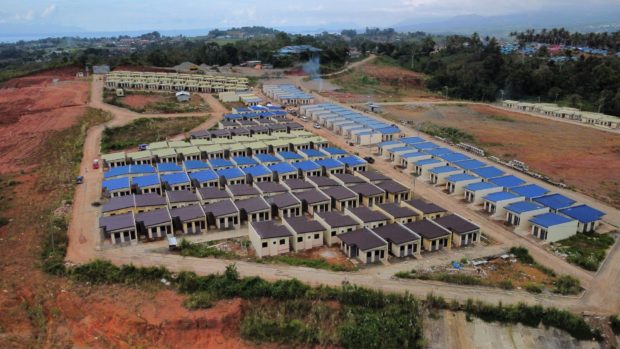
NEW HOME, NEW LIFE: Marawi residents displaced by the fighting between government troops and Islamic State-linked armed groups that laid siege to their city in 2017 are starting life anew in permanent shelters provided by the UN Habitat and the National Housing Authority. (Photo courtesy of the UN Habitat)
MANILA, Philippines — Major housing projects may not be completed by the time President Rodrigo Duterte steps down, including the rehabilitation of Marawi City that he pledged would be done before the end of his term, housing officials admitted on Tuesday.
The National Housing Authority (NHA) was unable to rise to the challenge posed by the President in June 2021: to complete the project in areas devastated in 2013 by Supertyphoon Yolanda (international name: Haiyan) within six months.
At present, the progress in the Marawi rehabilitation program remains at 85 percent, if Housing Secretary Eduardo del Rosario is asked. This was the same response he gave last September.
Since October 2017, when the military declared the end of the five-month battle between government troops and the Islamic State-linked Maute group that displaced around 350,000 Marawi residents, the government had prepared and mounted a rehabilitation plan.
But hundreds of families still live in government-built shelters, and thousands have temporarily settled in other parts of Northern Mindanao and in Metro Manila.
Del Rosario, who chairs Task Force Bangon Marawi, said the rehab program would be “90-95 percent” done by June 30, the end of Mr. Duterte’s term.
“Everything will be completed within the year,” he said at a press conference on Tuesday, the third anniversary of the creation of the Department of Human Settlements and Urban Development, that he heads.
No waste of funds
Del Rosario said the budget allocated for the entire Marawi rehab program had been distributed to agencies implementing their respective projects.
The rehab program was given P5 billion in the years 2020 and 2021, and P1 billion in 2022, all meant to have it finished within the year, he said.
There is “no possibility” of fund wastage “because the funding was given to the implementing agencies, and these … will surely complete the projects,” he added, issuing the reminder that the Commission on Audit (COA) would monitor the expenditures.
Del Rosario was confident that the Marawi rehab program would be completed within 2022, whether before or after the end of Mr. Duterte’s term, saying that the government was now “just finalizing, doing the finishing touches.”
“We are basically at 85 percent,” he said. “Other projects were completed, others are ongoing, others are about to start within the first quarter this year.”
No. 1 problem
Del Rosario said the main difficulty in completing the program was the purchase of lots in Marawi.
“It took us one to two years before we could purchase lots here. That was the No. 1 problem for us—the available lots for the housing units,” he said.
He cited the sudden increase in the costs of the lots to be bought by the government: “For example, we already bought the lot, only to find out that there were adverse fines. So there [were] setbacks.”
Housing officials cited a similar experience when they took over the housing project for communities affected by Yolanda from the preceding administration of President Benigno Aquino III.
Del Rosario said a “reassessment” was conducted by the Duterte administration because the number of housing units had ballooned to 225,000 from the original 185,000—or an increase of 30,000-40,000.
“There were sites considered for the housing units that were purchased, which turned out to be areas unfavorable to the displaced persons who will be relocated there,” he said without elaborating.
Different tune
In June 2021, the President challenged the NHA to complete the Yolanda housing program within six months.
The deadline lapsed in December, but the NHA sang a different tune, saying its actual commitment was to get the program done in June.
“That is the commitment of the NHA and right now, we are still on track to complete these projects by the end of the term of the President,” NHA Assistant General Manager Victor Balba said at the same press conference.
He said the housing program was 82 percent complete.
Balba said the other issues that hampered the completion of the program were the slow release of land titles and the difficulty of developers in securing the “necessary permits.”
He said “some projects” were “still ongoing.”
“Some of these projects were bid out again because some of the developers were not able to comply with the requirements. Hence, we terminated them and had [the contracts] awarded again,” Balba said.
In its 2020 audit report released last year, the COA said the NHA had failed to meet its target of giving 218,975 housing units to Yolanda-displaced families.
It found that only 139,516 housing units, or 64 percent of the target, were completed by the NHA and the local government in 2020.
The COA said the NHA failed to meet its targets because of delayed construction, slow turnover, and low occupancy.
Meanwhile, infrastructure projects under the Marawi rehab program were inaugurated only last January, or almost five years after the siege of the city.
These include the Pumping Bridge in Barangay Raya Madaya and Lilod Madaya Barangay Complex, key facilities that were damaged during the siege.
Other ongoing projects involve Rizal Park, Marawi Convention Center, Peace Memorial, School of Living Traditions, Marawi Museum, and Lanao Lake Promenade — all on Ground Zero.
—WITH A REPORT FROM INQUIRER RESEARCH
SOURCES: Inquirer Archives, dhsud.gov.ph
RELATED STORIES
Scarcity of land delays Marawi housing projects
Housing Marawi folk top task for gov’t

